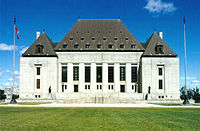Calder v British Columbia (AG)
| Calder v British Columbia (AG) | |
|---|---|

|
|
| Hearing: November 29 - December 3, 1971 Judgment: January 31, 1973 |
|
| Full case name | Frank Calder et al., suing on their own behalf and on behalf of All Other Members of the Nishga Tribal Council, and James Gosnell et al., suing on their own behalf and on behalf of All Other Members of the Gitlakdamix Indian Band, and Maurice Nyce et al., suing on their own behalf and on behalf of All Other Members of the Canyon City Indian Band, and W.D. McKay et al., suing on their own behalf and on behalf of All Other Members of the Greenville Indian Band, and Anthony Robinson et al., suing on their own behalf and on behalf of All Other Members of the Kincolith Indian Band v. Attorney-General of British Columbia |
| Citations | [1973] S.C.R. 313 |
| Prior history | Judgment for the Attorney General of British Columbia in the British Columbia Court of Appeal. |
| Ruling | Appeal dismissed. |
| Holding | |
| While aboriginal title can exist, more was required to demonstrate that the aboriginal bands in question had such title. | |
| Court Membership | |
| Chief Justice: Gérald Fauteux Puisne Justices: Douglas Abbott, Ronald Martland, Wilfred Judson, Roland Ritchie, Emmett Hall, Wishart Spence, Louis-Philippe Pigeon, Bora Laskin |
|
| Reasons given | |
| Majority | Judson J., joined by Martland and Ritchie JJ. |
| Concurrence | Pigeon J. |
| Dissent | Hall J., joined by Spence and Laskin JJ. |
| Fauteux C.J. and Abbott J. took no part in the consideration or decision of the case. | |
Lua error in package.lua at line 80: module 'strict' not found. Calder v British Columbia (AG) [1973] S.C.R. 313, [1973] 4 W.W.R. 1 was a decision by the Supreme Court of Canada. It was the first time that Canadian law acknowledged that aboriginal title to land existed prior to the colonization of the continent and was not merely derived from statutory law.
In 1969, Frank Arthur Calder and the Nisga'a Nation Tribal Council brought an action against the British Columbia government for a declaration that aboriginal title to certain lands in the province had never been lawfully extinguished.
At trial and on appeal, the courts found that if there ever was aboriginal title in the land it was surely extinguished.
The Supreme Court found that there was indeed an aboriginal right to land that existed at the time of the Royal Proclamation of 1763. However, the Court was split 3 to 3 on whether the claim to land was valid. One group claimed that though title existed it had been extinguished by virtue of the government's exercise of control over the lands, while the other group required that more be done to show extinguishment.
Aftermath
With this decision the government of Canada overhauled much of the land claim negotiation process with aboriginal peoples. The basis for aboriginal title was later expanded on in Guerin v. The Queen, [1984] 2 S.C.R. 335, and most recently in Delgamuukw v. British Columbia [1997] 3 S.C.R. 1010. DC
The case for the Nisga'a was argued by Thomas Berger, subsequently Mr. Justice Thomas Berger, in his first major advocacy role in Canadian Aboriginal law.
See also
External links
- Full text of Supreme Court of Canada decision at LexUM and CanLII
- case summary